-
Describe the Rutherford scattering experimentA beam of alpha particles was directed at a thin gold foil Occurs in a vacuum so that no collisions between air particles an alpha particles occur The experiment was done in order to determine structure of an atom
-
In the Rutherford scattering experiment it was observed that most of the alpha particles passed straight through. What can we infer from that?That most of the atom is made from empty space
-
What evidence was there that suggested that the nucleus had a positive charge?Because the nucleus repels the alpha particles and caused it to deflect from its original path, some of them even bounced back
-
Plum pudding modelJJ Thompson - after discovery of electtron but before nucleus positive cloud with electrons embedded in it
-
What adaptations should be made to ensure the experiment is carried out as accurately as possible?
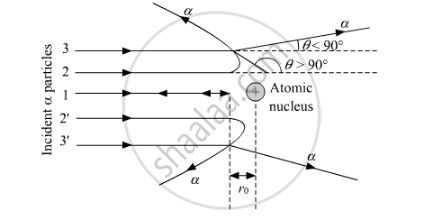 The beam of particles of alpha have to be very this in order to be more certain of the scatterin angle, so angle of deflection can be measured from a known original direction (deflection angle is more accurate) Gold foil has to be very thin to reduce the possibility of multiple scattering by many atoms.
The beam of particles of alpha have to be very this in order to be more certain of the scatterin angle, so angle of deflection can be measured from a known original direction (deflection angle is more accurate) Gold foil has to be very thin to reduce the possibility of multiple scattering by many atoms. -
What happens if the alpha particle does not penetrate the nucleus?the nucleus can be a point charge at the centre, coulomb's law can be used if it doesn't penetrate the nucleus we can use the method of closest approach to caluclate the size of the nucleus
-
What happens to the kinetic energy of the alpha particle as it is fired at the nucleusKE converted to EPE KE of alpha particle converts to potential energy by doing work against the electric field
-
EPE of alpha particles fired at nucleusE = (charge of alpha particle) x (charge of nucleus) / 4pi(e0)rc charge of alpha particle = 2e charge of nucleus = ze rc = nuclear radius upper limit
-
considerations for the method of closest approachThe nucleus is considered to be a point charge, at this scale it is not The alpha particles are stopped some distance away from the nucleus Takes higher energy particles to penetrate the nucleus The values for the nuclear radius given by other particles such as p, n and e- are different It is assumed the nucleus remains in one place when in reality it is slightly repelled by the alpha particle
-
electron scatteringmore accurate way to determine nuclear radius electrons interact with the nucleus only with em interaction but alpha particles with sn which is not well understood the scattering of electrons is like the diffraction of waves around a spherical object
-
electron sacttering equation
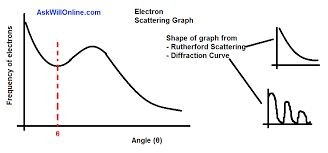 sintheta(angle between 0th order and first minima) = 0.61 x wavelength / R(radius of nucleus) wavelength - de broigle wavelegnth for high energy electrons 2.65 x10^-15 m
sintheta(angle between 0th order and first minima) = 0.61 x wavelength / R(radius of nucleus) wavelength - de broigle wavelegnth for high energy electrons 2.65 x10^-15 m -
electron scattering considerationselectrons need to have a de broigle wavelegnth of ~nuclear diameter high energy needed wlwctron difraction are not zero minima boundary is fuzzy various methods determinimg minima give variable results electrons typically travelling at relativistic speeds so wavelength = h/mv=hc/Energy
-
3 types of radiation
Alpha
Beta
Gamma
-
Most to least ionising radiation
Alpha
Beta
Gamma
-
Most to least ionising radiation
Gamma
Beta
Alpha
-
What can alpha radiation be blocked by
Alpha radiation
-

Electron capture
-
When a nucleus decays through gamma radiation, how does the atomic number and mass number change?
They remain the same as the number of protons and neutrons remain the same
-
Why is ionising radiation seen as dangerous
Because it can kill or mutate cells, which could lead to mutations and lead to things such as cancer
-
Which radiation is more harmful inside a human body, alpha or gamma?
Alpha radiation - because it has a high ionising power so it would damage more cells. It is also very poorly penetrating, therefore it is not be able to leave the body, whereas gamma radiation is highly penetrating
-
Give an example of a real life use of beta decay and explain why beta is chosen for this
Beta radiation can be used to measure the thickness of paper or aluminium foil. Alpha isn’t used as it is less penetrative and wouldn’t reach the detector on the other side of the sheet. Gamma radiation is too penetrative and would pass through everything
-
Which type of radiation follows the inverse square law
Gamma
-
What does the inverse square law stated ?
The intensity is inversely proportionality to the square of the distance from the source
-
What is intensity measured in?
Measured in watts per square meter
-
Describe an experiment which be used to show the inverse square law and gamma rays
Firstly measure background radiation (using GM tube) without the gamma source in the room
Then put the gamma source at a set distance from the GM tube and measure the count rate per minute. Record 3 measurements for each distance and take an average 10cm intervals
Take away the background radiation from each reading
Square each of the distances
Plot a graph of the count rate per minute against 1 over distance squared (1/d^2)
If it is a straight line through the origin then it confirms they are directly proportional
-
What is background radiation?
Radiation that is constantly in the constantly in the surrounding from sources such as rocks and food.
-
What is the decay constant ?
The probability of a nucleus decaying per second
-
What are the units for the decay constant?
S^-1
-
What is half life?
The time it takes for half of the unstable nuclei in a substance to decay
-
What equation can you use to work out the half life of an object?
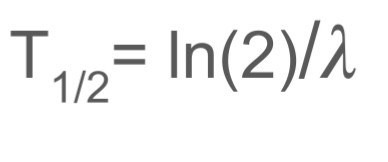
-
activity
LamdaN
-
What is activity measured in
Bq decays per second
-
True or false radioactive isotope decay exponentially
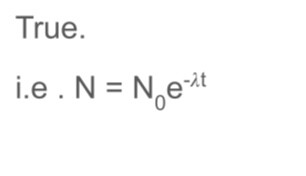
-
Why is technetium 99m useful in medicine
Because it releases gamma radiation
It has a short half life therefore it doesn’t stay highly radioactive for long
Half life for 6 hours long enough for it to be detected
It can also be made near to the hospital
Easy to detect outside the patient
‘Clears away’ after a few days
-
What does the graph of N against Z show
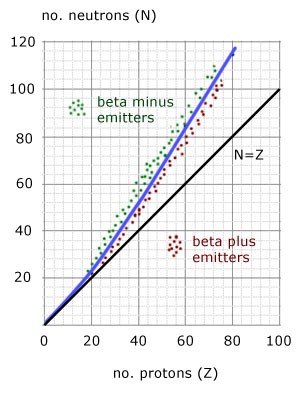
It shows the relationship between proton number and neutron number
The graph shows a stability curve which starts as N=Z until N value of 20
After that the graph curves upward and becomes steeper
-
Where on the curve does B - decay occur and why?
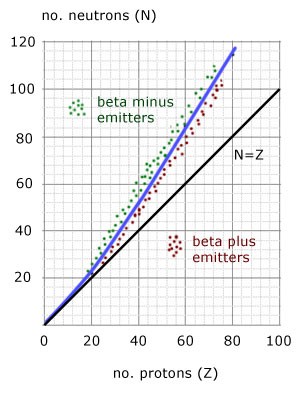
Above the stability line, because the nuclei found there contains too many neutrons
Therefore when beta minus decay occurs the neutron turns into a proton and it becomes more stable
-
What type of decay occurs below the stability line and why
Beta plus decay. As the isotopes found here often have too many protons. Therefore when beta plus decay occurs the proton turns into neutrons
-
How does the heavier nuclei often decay?
Through alpha decay
This is because alpha decay emits a helium nucleus - 2 protons and 2 neutrons - therefore causing the nuclei to become less heavy and more stable
-
An alpha particle is fired at a nucleus with ke at the start known conservation of energy can be used to find closest approach of a particle

-
How is electron diffraction used to determine the diameter of a radius
An electron beam is fired at a thin sheet of the desired atom
A diffraction pattern is produced on a screen behind
Using the angle of a minimum we cam use equations to calculate the diameter
-
What is the relationship between R nuclear radius and A nucleon number

-
True or false the density of a nuclea is independent of the radius of the nucleus
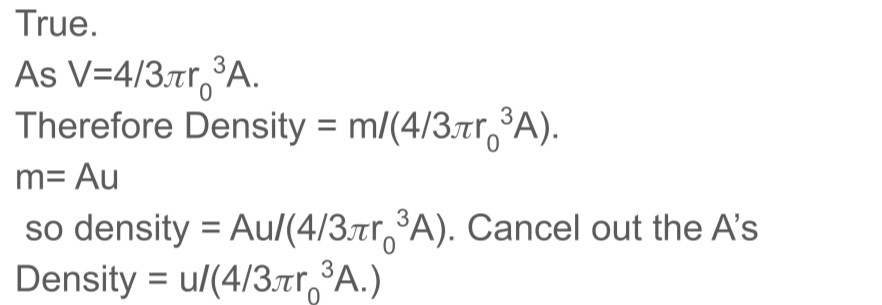
-
Mass to energy equation
E = mc^2
-
What is the mass defect?
The difference between the total mass of all the nucleons separately compared to the mass of the nucleus
-
Why is there a mass defect
Because energy is needed to bring the constituent parts of a nucleus together, therefore the mass equivalent of the energy is lost and the total mass decreases
-
What is binding energy?
The energy required to separate a nucleus into its constituent parts
-
Binding energy graph
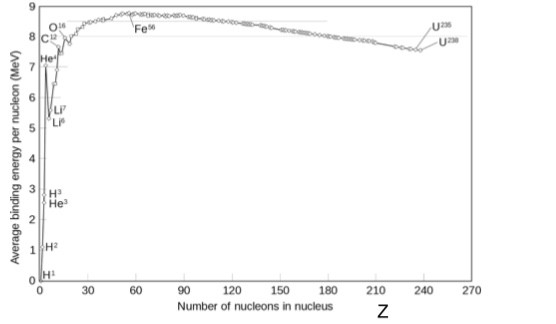
-
What is nuclear fission
Where a unstable nucleus splits into 2 smaller nuclei
Often occurs with the larger nuclei
The binding energy per nucleon increases when fission occurs therefore the overall process releases energy
-
What is fusion
When two small nuclei fuse together to create a larger nuclei
The new nucleus has a larger binding energy per nucleon than the old nuclei therefore energy is released in the process
-
Why is it difficult to make fusion occur on earth?
There is a large repulsion between the two positively charged nuclei, therefore alot of energy is required to overcome the repulsion and fuse them together
It is hard to get a material that can withstand the heat and be cost effective
-
How is fission used in nuclear reactors
Rods of uranium-235 absorb neutrons and become unstable and then split into two daughter nuclei
It also releases 2/3 more neutrons
These then go on to be reabsorbed by another uranium-235
-
What is the purpose of a moderator
To slow down the neutrons so they travel slow enough to be absorbed by the uranium
They do this through elastic collisions between the moderator and nucleus
-
Why is control rods essential for nuclear power station
They stop the chain reaction from being being out of control
They absorb neutrons so that only 1 of the neutrons released in each reaction can go on to be absorbed by another uranium
If not then the nuclear reactor would overheat as too many reactions would happen at once
-
Is boron used as a control rod or a moderator?
Boron
-
Give an example of a material that can be used as a moderator?
Water
-
What is the purpose of using water as a coolant?
It allows heat from the nuclear reactor to escape which stops the reactor from overheating
-
What is the critical mass?
The minimum mass of fuel needed for a chain reaction to occur
-
Which waste products from a nuclear reactor cause the highest risk
Spent fuel rods are extremely radioactive
-
How is high level waste disposed
They are first stored in cooling ponds
Vitrified
Then they are put in sealed steel containers and put deep underwater
-
What is low level waste contained in
sealed in containers and put underground until it is safe again
-
How to get work done by a gas
pxchangeinv
Area under pvgraph

